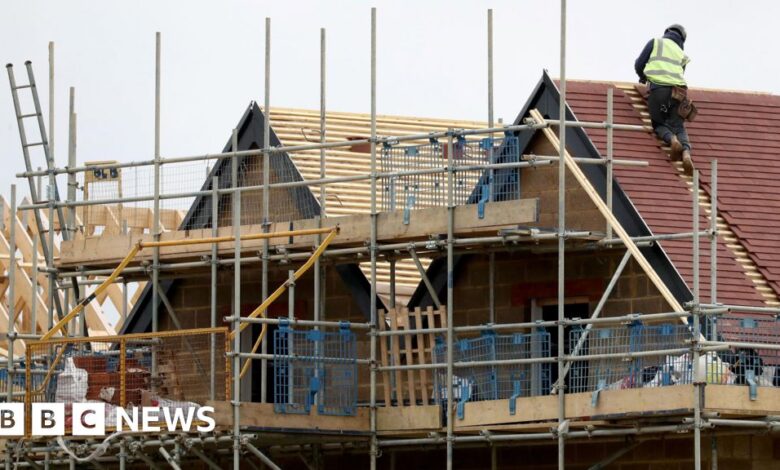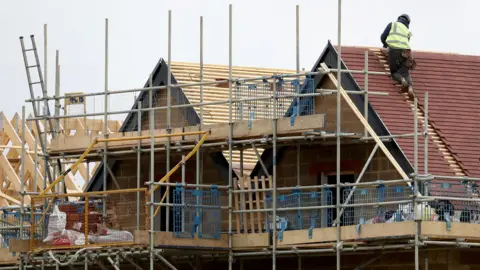Drive for new housing could swamp services, county councils warn

 PA Media
PA MediaThe government’s drive for new housing risks overwhelming local roads, schools and GP services in England’s rural areas and small towns, a group of county councils has warned.
The government has been consulting on plans to introduce mandatory housing targets that would push more development away from major city centres.
A survey by the County Councils Network (CCN), which represents authorities that manage local infrastructure for half of England’s population, found its members feared there were not sufficient services to meet supply.
A spokesperson for the Ministry of Housing, Communities and Local Government said: “We reject any claims that these targets are excessive.”
“We are facing a serious housing crisis so all areas of the country must play their part in building the homes that Britain badly needs,” the spokesperson said.
The government would “work in partnership with councils to create the vital infrastructure that people need in their communities”, they added.
On average, local authorities represented by the CCN will see a 56% rise in the number of new homes required – equivalent to more than 64,000 properties per year.
Richard Clewer, CCN housing spokesperson, said councils “don’t have enough infrastructure to cope now”, let alone with upcoming projects.
“Councils in rural and county areas are not anti-housing and the vast majority support the principle of nationally set targets. But these targets are excessive.
“We also must remember much of this development in county areas will be in the places with limited or no public transport, compared to the benefits of building in or around cities where there is already good infrastructure.”
The CCN also warned that communities could face a developer “free for all” involving speculative housebuilding in unsuitable places, risking driving “a bulldozer through locally-led planning decisions”.
Compulsory targets
Labour has put housing reforms at the heart of its mission to drive economic growth since taking office in July.
During the general election campaign, the party pledged to get 1.5 million homes built in five years by “unblocking” the planning system.
Latest figures show the number of housing projects given the go-ahead by councils in England fell to a record low in the final months of the last government.
Since July, the government has been consulting on sweeping changes to England’s National Planning Policy Framework (NPPR), the guidelines which govern the home planning system.
The plans include setting mandatory local housing targets, which the government says will be distributed according to the size of existing communities and the need to address housing shortages in high-demand areas.
The proposed changes would see a major shift in the areas new homes were built – resulting in a surge in new housing in smaller towns and the countryside.
Some built-up areas like Westminster and Bolton in Greater Manchester are also earmarked for more homes, but the general trend will mean major cities such as London, Birmingham and Coventry being expected to construct thousands fewer homes than implied by current targets.
‘Grey belt’
The CCN represents England’s 20 county councils and 17 unitary authorities in shire areas.
This month the CCN has surveyed its members – made up of 29 Conservative, six Lib Dem and two Labour local authorities – about the proposals.
None of the 21 councils which responded supported the government’s new target for their area, with 94% saying the targets were excessive.
Nine in 10 councils blamed a lack of infrastructure, and more than half said there was a lack of suitable land for the proposed new housing numbers.
The CCN called for the current system of allowing councils to set their own local plans that guide development in their areas to continue.
Local authorities are meant to create these plans through consultation with residents, businesses and local stakeholders.
Labour has maintained the reforms will supply infrastructure – schools, GP surgeries, transport links and green spaces – alongside new housing.
Announcing the plans, Deputy PM and Housing Secretary Angela Rayner said the government would ensure “people get the homes they need locally and see the infrastructure that improves nature and their local area”.
If the new guidance comes into place, councils will have to demonstrate they have a five-year supply of deliverable housing sites to meet the new targets.
If there is not enough land to meet housing targets, councils will be encouraged to build on a new category of “grey belt” land, which Labour says will consist of poor-quality parts of the green belt – areas of land that are protected from most forms of development.




